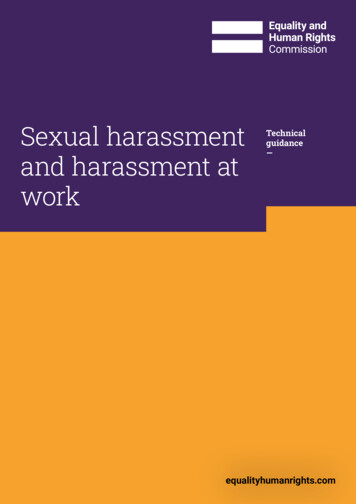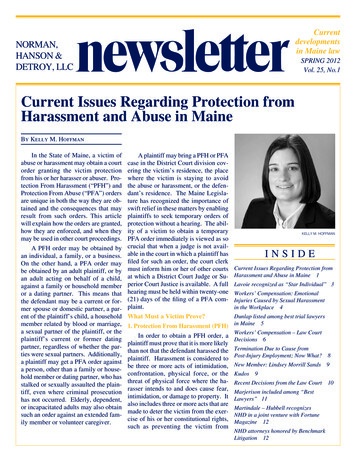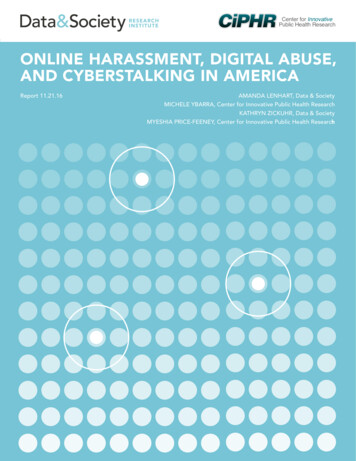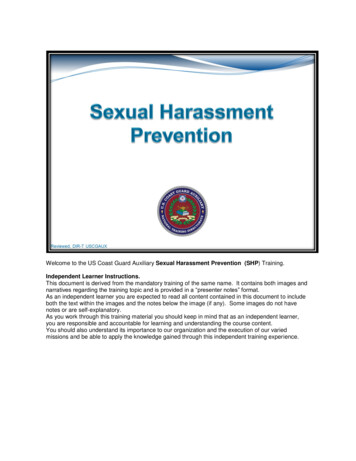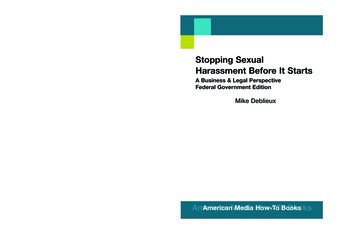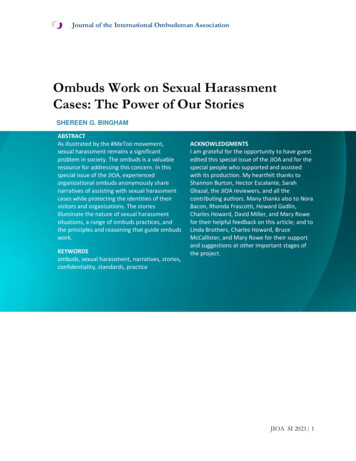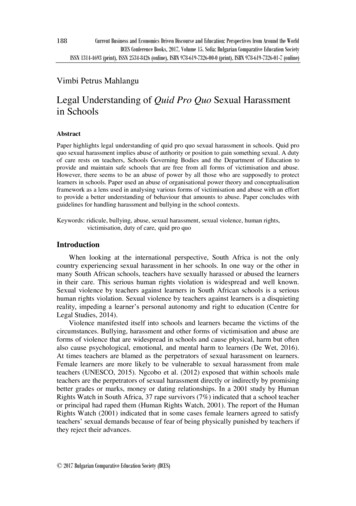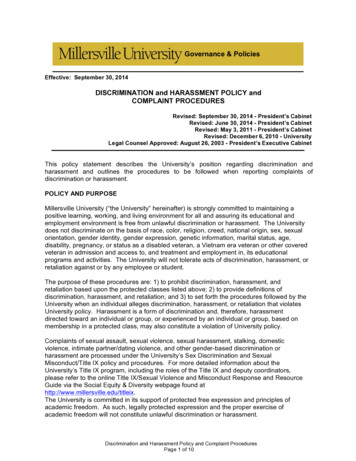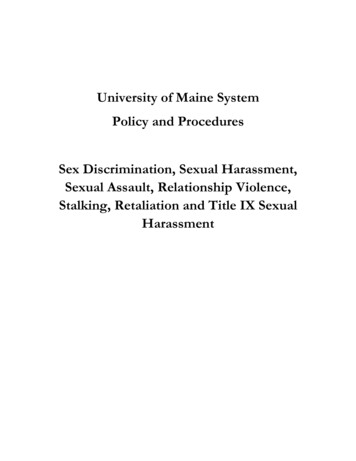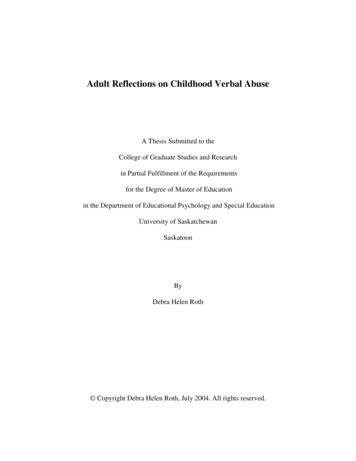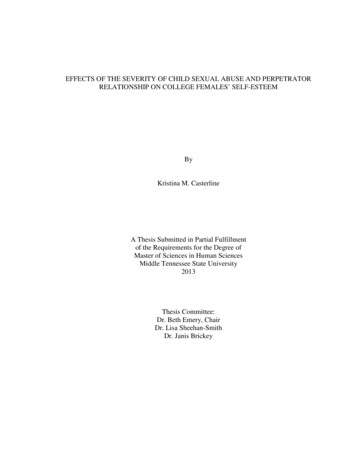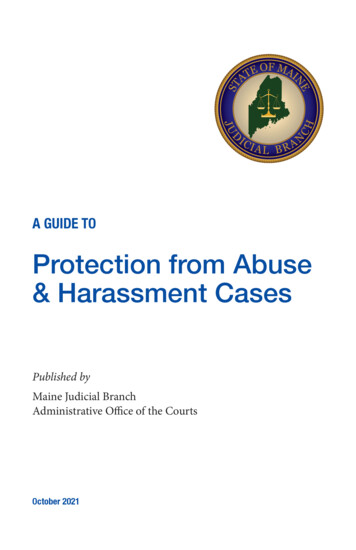
Transcription
A GUIDE TOProtection from Abuse& Harassment CasesPublished byMaine Judicial BranchAdministrative Office of the CourtsOctober 2021
COURT FORMSElectronic copies of the forms below can be found on the Judicial Branch'swebsite www.courts.maine.gov/forms/index.html. Paper forms may be obtained at any district court clerk's office at no charge.To start a protection from abuse or protection from harassment case,complete either: PA-001 Complaint for Protection from Abuse OR PA-006 Complaint for Protection from Harassment.Forms used in both protection from abuse and protection fromharassment cases: PA-017 Important Notice to Plaintiff (warns the plaintiff that it is a crime tomake a false statement) (required). PA-005 Protection Order Service Information (helps law enforcement locatethe defendant to give notice of the case) (required). PA-015 Affidavit for Confidential Address/Telephone Number (used if asking for the plaintiff 's address/telephone number to be kept confidential)(optional).ADDITIONAL FORMS FM-050 Child Support Affidavit (in a protection from abuse case, if theparties have minor children together and no child support order is inplace). P A-012 Plaintiff ’s Pre-Judgment Motion to Dismiss Complaint (onlyplaintiff can file). PA-013 Motion to Extend Order for Protection (only plaintiff can file). PA-022 Plaintiff ’s Post-Judgment Motion to Modify/Motion to TerminateProtection Order (only plaintiff can file). PA-010 Defendant’s Motion to Dissolve Temporary Order for Protection orto Modify/Amend (with incorporated Affidavit) (only defendant can file).
A GUIDE TO PROTECTION FROM ABUSE & HARASSMENT CASESPROTECTION CASESThe information in the table below is meant to help get you started. Please readthe entire guide for more information.Protection from ABUSEProtection from HARASSMENTRegardless of your age, you can file aPFA against your family or householdmember or your current or formerdating partner who has abused you.Regardless of your age you can file aPFH against anyone if you have been avictim of that person's:Regardless of your age, you can alsofile a PFA against anyone who has: stalked you sexually assaulted you; w ho has used or threatened to useintimate private images of youagainst you; or h as forced you or led you into sextrafficking.If you are 60 or older, or a dependentor incapacitated adult, you can filea PFA against any extended familymember or unpaid care provider whohas abused you. (Please read part A.1because “abuse” in these situations hasa broader definition).If you are a minor, your parent or other person responsible for you can geta PFA on your behalf against anyonewho has sexually exploited you; s hared or intends to share sexuallyexplicit images of you (only if youare 16 years or under); or h arassed you by telephone or byelectronic devices.MAINE JUDICIAL BRANCH H arassment (which means three ormore acts of intimidation, confrontation, actual or threatenedphysical force by the defendant,made with the intention of causingfear, intimidation, or damage topersonal property, and that do infact cause fear, intimidation, ordamage to personal property); A single act or course of conductconstituting a serious criminal actsuch as: assault,criminal threatening,sexual assault,terrorizing,kidnapping,aggravated assault,arson,violation of privacy; or V iolation or interference with yourconsitutional or civil rights.(Please note that if you are a minorchild, your parent or other personresponsible for you will have to file thePFH on your behalf).i
A GUIDE TO PROTECTION FROM ABUSE & HARASSMENT CASESQUESTIONS ABOUT PROTECTION CASESAre there fees or costs to file a case?There are no fees to file a Complaint for Protection from Abuse (PA-001).There may be a fee to file a Complaint for Protection from Harassment (PA-006).See Part B.6 for more information. The clerk's office will tell you what the filingfee is. You may ask the court to waive the filing fee if you cannot afford to pay it.What forms or information must I file?See the list of required and optional forms on the inside front cover of this guide.Can I get a protection order right away (without notifying the defendant inadvance)?Perhaps, if a judge is available to review your complaint and if the judge decidesthe evidence you have submitted supports a temporary protection order. Theclerk will let you know when a judge will be available to review your request for atemporary order.If a judge determines that your complaint does not qualify for a temporary protection order, you may still decide to go forward with a hearing or to withdrawthe case (with the option of refiling later). If you receive a temporary order or, ifyou do not receive a temporary order but still decide to go forward, the clerk'soffice will notify you and the defendant of the hearing date.When do I and the defendant come back to court for a final hearing?The court will schedule a hearing in a protection from abuse case within 21 daysafter the filing of the abuse complaint.The court will schedule a hearing in a protection from harassment case as soon aspracticable, but will not always be scheduled within 21 days after the filing of theharassment complaint.iiMAINE JUDICIAL BRANCH
A GUIDE TO PROTECTION FROM ABUSE & HARASSMENT CASESCONTENTSINTRODUCTION . 1PART A — PROTECTION FROM ABUSE. 31. What actions may qualify somone to file for a protection from abuse order?. 32. Who can ask a court for a protection from abuse order?. 43. How is a protection from abuse case started?. 44. Which district court should the plaintiff go to?. 55. Fees. 56. Tips for filling out the abuse complaint. 57. Special situations. 68. Process for getting a temporary protection order. 69. Restrictions on the defendant's right to own, receive, orpossess firearms, other dangerous weapons, or ammunition. 710. Providing information on dangerous weapons. 811. Service on the defendant. 812. What court papers will the defendant receive?. 913. When does a temporary protection order take effect?. 914. When will the court schedule a final hearing?. 915. Rights and responsibilities of a defendant. 1016. Request to modify or dissolve a temporary order . 1117. If a temporary order prohibits the defendant frompossessing firearms or dangerous weapons. 1118. Points to keep in mind before the final hearing. 1219. Requesting a postponement of the hearing. 1220. What to expect at court. 1321. Order by consent (without a hearing). 1322. What happens in a final hearing?. 1323. What relief may be included in a protection from abuse order?. 1524. How long may a final protection from abuse order last?. 1625. What is the defendant violates the order?. 1726. If a final order prohibits the defendant frompossessing firearms or dangerous weapons. 1727. Changing or ending a final protection order. 17MAINE JUDICIAL BRANCHiii
A GUIDE TO PROTECTION FROM ABUSE & HARASSMENT CASES28. If the plaintiff wants the protection order extended. 1829. Protection from abuse order issued by a court in another state. 1830. Appealing a final protection from abuse order. 19PART B — PROTECTION FROM HARASSMENT. 191. What is harassment?. 192. Who can ask a court for a protection from harassment case?. 203. Who can be a defendant?. 204. How do you start a protection from harassment case?. 205. Which district court should the plaintiff go to?. 216. Fees. 217. Tips for filling out the harassment complaint. 218. Can a plaintiff get a temporary protection from harassment order?. 219. When will a final hearing be held in a protection from harassment case?. 2210. Service on the defendant . 2211. Rights and responsibilities of a defendant. 2212. Scheduling a final hearing in a protection from harassment case . 2313. What to expect at court. 2314. Orders by consent (without a hearing) . 2315. What happens in a final hearing?. 2316. What relief can be included in a final protection from harassment order? . 2317. How long may a protection from harassment order last? . 2418. What if the defendant violates the protection from harassment order? . 2519. Protection from harassment orders issued by another state . 2520. Appealing a final protection from harassment order. 25Definition of Key Terms. 26Appendix A: District Courts . 32Appendix B: Sheriffs' Offices & Maine State Police Locations. 34Appendix C: General Information. 35Important DisclaimerThe specific requirements concerning your case are contained in thestatutes, rules, and administrative orders. This is only a guide. This guidedoes not contain legal advice.ivMAINE JUDICIAL BRANCH
A GUIDE TO PROTECTION FROM ABUSE & HARASSMENT CASESINTRODUCTIONThis guide explains how to file for a temporary and final court order for protection from abuse or protection from harassment.HOW ARE THE LAWS DIFFERENT?The protection from abuse and protection from harassment laws differ from oneanother in several ways. Although both are civil laws and have the same generalcourt process, each law has its own requirements. Part A of this guide explainsprotection from abuse; Part B explains protection from harassment. Sometimesthe laws are referred to collectively as the “protection laws.”The protection laws can be found in the Maine Revised Statutes as follows:Title 19-A, Sections 4001-4014 (protection from abuse);Title 5, Sections 4651-4661 (protection from harassment); and Title 17 and 17-A (sections of the Maine Criminal Code referenced inTitle 19-A and Title 5).The Maine Revised Statutes are available online at:www.mainelegislature.org/legis/statutes. The statutes contain the specific legallanguage and requirements that a judge applies when deciding a case under theprotection laws.USING COURT FORMSThe Maine District Court has forms you must use in protection cases. The district court clerk can give you copies of the forms to be completed and can answergeneral questions. Clerks cannot help you determine which forms to use or tellyou what to put in the forms. Clerks and court staff are not allowed to give legaladvice.Most of the forms can also be found online at:www.courts.maine.gov/forms/index.html.People who do not have access to a computer and printer should go to a districtcourt or call the domestic violence or sexual assault statewide helpline at thenumbers listed on the back of this guide.MAINE JUDICIAL BRANCH1
A GUIDE TO PROTECTION FROM ABUSE & HARASSMENT CASESA list of forms for both protection from abuse and protection from harassmentcases can also be found on the inside front cover and following page of this guide.THIS GUIDE IS FOR INFORMATIONAL PURPOSES ONLYGoing to court, especially if you do not have a lawyer, can be stressful and challenging. This guide was written to help unrepresented parties who are involvedin protection from abuse or harassment cases better understand the process. Tomake the guide more readable, some sections of statutes, rules or administrativeorders that apply have been shortened or summarized.When the guide refers to things a plaintiff or a defendant must or may do, thepronoun “you” may be used. “You” may mean either party in the case dependingupon the specific section of the guide.While we have tried to ensure that the information is accurate and clear, pleaseremember that the language of the statutes and other sources of law is the finalword. If there is any conflict between the law and this guide, the law controls.In addition, the guide describes the general procedures and requirements of thegoverning laws. The court’s decision in individual cases will take into consideration the specific facts and circumstances of each case.We have included a simple glossary of key legal terms at the end of the guide.Words in bold are defined in this section.A FINAL WORD ON FILING ANY KIND OF COURT CASEA protection from abuse or harassment case should be started only when courtinvolvement is necessary to protect a person or property from real harm.Please note that: It is a crime to make a false statement under oath in a court document orhearing. If you make a false statement in a court document or at a hearing, you mayhave to pay the other party’s court expenses and attorney fees. A parent’s misuse of the protection process to attempt to gain an advantagein a family matter may be considered by the court when deciding parentalrights and responsibilities.2MAINE JUDICIAL BRANCH
A GUIDE TO PROTECTION FROM ABUSE & HARASSMENT CASESPART A — PROTECTION FROM ABUSE1. W hat actions may qualify someone to file for a protection from abuseorder? Attempting to cause or causing physical injury or offensive contact,including sexual assault; Attempting to place, or placing, another in fear of bodily injury throughthreatening, harassing or tormenting behavior; Compelling a person by force, threat of force or intimidation to do something or not do something that the person has a right or privilege to do ornot do; Knowingly restricting substantially the movements of another person without that person’s consent; Communicating to a person a threat to commit, or to cause to be committed, a crime of violence dangerous to human life; Repeatedly, and without reasonable cause, following the plaintiff or beingat or in the vicinity of the plaintiff ’s home, school, business, or work; Stalking; Engaging in sexual assault; Knowingly, and with the intent to harass, torment or threaten, disseminating a private, sexually explicit image of the plaintiff or another personwithout consent; Engaging in sex trafficking or aggravated sex trafficking; Sexually exploiting a minor; Disseminating or intending to disseminate sexually explicit images of aminor aged 16 years or younger; Harassing a minor by telephone or by electronic devices; or Financial exploitation, or the intentional, knowing, or reckless deprivation of essential needs, if the abuse involves an incapacitated adult,dependent adult, or individual 60 years of age or older.MAINE JUDICIAL BRANCH3
A GUIDE TO PROTECTION FROM ABUSE & HARASSMENT CASESIf the actions do not meet the requirements for a protection from abuse order asspecifically defined in the abuse law, the plaintiff may want to explore eligibilityfor a protection from harassment order. See Part B of this guide for more information on protection from harassment cases.2. Who can ask a court for a protection from abuse (PFA) order? Regardless of your age, you can file a PFA against your family or household member or your current or former dating partner who has abusedyou. (Please note that if you are a minor child, your parent or other personresponsible for you will have to file the PFA on your behalf.) Regardless of your age, you can also file a PFA against anyone who has: stalked you; sexually assaulted you; used or threatened to use intimate private images of you against you; or forced you or led you into sex trafficking. If you are 60 or older or a dependent or incapacitated adult, you can file aPFA against any extended family member or unpaid care provider whohas abused you. (Please read part A.1 because “abuse” in these situations hasa broader definition). If you are a minor, your parent or other person responsible for you can alsoget a PFA on your behalf against anyone who has: sexually exploited you; s hared or intends to share sexually explicit images of you (only if youare 16 years or younger); or harassed you by telephone or by electronic devices.3. How is a protection from abuse case started?Plaintiffs:1. Fill out a Complaint for Protection from Abuse (PA-001) (abuse complaint)and other forms that apply (see the list of forms in the front of the guide).2. Sign the forms in front of a notary, attorney, or court clerk, and give theforms to the district court clerk's office.4MAINE JUDICIAL BRANCH
A GUIDE TO PROTECTION FROM ABUSE & HARASSMENT CASESYou can go to the clerk’s office in person to fill out and submit the forms or youcan fill out the forms online, print, and then take them to the district court to file.The clerk's office can help you complete the forms but cannot tell you what to putin the forms or give legal advice.You may also mail the completed forms to the court. However, if you choose tonot go to the court in person to file the forms, you will be losing the opportunityto be heard in person before a request for a temporary relief is denied.A protection from abuse order is effective when it is signed by a judge. However,the order must be served on the defendant before that person can be chargedwith a crime for violating the order, unless the defendant has earlier actual noticeof a protection order. For more information about service on the defendant, seePart A.10.4. Which district court should the plaintiff go to?A plaintiff should go to the district court location where the plaintiff lives, wherethe defendant lives, or where the plaintiff is currently staying if the plaintiff hasmoved out of the home for safety reasons.A list of district courts can be found at the end of this guide in Appendix A andonline at www.courts.maine.gov/courts/district/index.html. If someone is unsureas to which court to go to, a list of district court by city or town can be foundonline at: www.courts.maine.gov/courts/find-by-town.html.5. FeesThere are no court filing or service fees for plaintiffs in protection from abusecases.6. Tips for filling out the abuse complaint Fill out the abuse complaint form completely. The last section of the abusecomplaint form asks you to check boxes for the relief you are requesting. Besure to check any and all boxes that you would like the court to consider. Give as much detail as possible. What specifically did the defendant do orsay, what injuries or harm did you (or, if you are submitting on behalf of achild plaintiff) suffer, or are in danger of suffering? Statements such as, “thedefendant stalked me,” or “the defendant threatened to harm my child” donot give enough information for the court.MAINE JUDICIAL BRANCH5
A GUIDE TO PROTECTION FROM ABUSE & HARASSMENT CASES If you do not want the defendant to know where you are staying for safetyreasons, fill out and file an Affidavit for Confidential Address/TelephoneNumber (PA-015) form. The defendant will not be able to see your currentaddress or telephone number. The court does, however, need to have yourcontact information so the clerk’s office can contact you about the case. Keep the clerk informed of any address changes. The Notice of Change ofAddress (CV/CR-199) form may be used for this purpose.7. Special situationsSexually explicit imagesIf a case involves the defendant releasing a private, sexually explicit image without consent, any images submitted with the abuse complaint are automaticallyplaced under seal by the court. This means the images will not be able to beviewed by or released to the public. The defendant and the defendant’s attorneywill be able to view the images only at the courthouse, and only for the purposeof preparing a response to the abuse complaint.Firearms or dangerous weaponsThe court may prohibit the defendant from possessing firearms or other dangerous weapons in a protection case if certain conditions are met. See Part A.9 fordetailed information.8. Process for getting a temporary protection orderThe judge may grant a temporary order if the judge believes there is good causeto do so. Good cause means there is immediate and present danger of abuse tothe plaintiff or a minor child.If you file an abuse complaint in person at the courthouse, the clerk will presentthe abuse complaint to the judge as soon as possible and will give you other information about what will happen next.You may be asked to wait at the courthouse until a judge can review the abusecomplaint. Please follow all of the court clerk’s instructions.The judge may discuss the abuse complaint with you, including asking additionalquestions about your abuse complaint. If the judge believes the information youhave given qualifies for immediate relief, the judge will sign the order.6MAINE JUDICIAL BRANCH
A GUIDE TO PROTECTION FROM ABUSE & HARASSMENT CASESThe temporary protection can include some or all of the relief you have asked forin the abuse complaint.The temporary protection order is effective when it is signed by the judge but theorder must be served on the defendant before that person can be charged with acrime for violating the order, unless the defendant has earlier actual notice of theorder.The court will schedule a final hearing within 21 days after the date the case isfiled. A final protection from abuse order may last up to two years.If you withdraw the case before a final hearing, any temporary protection orderthat was granted will no longer be in effect.9. Restrictions on the defendant's right to own, receive, or possess firearms,other dangerous weapons, or ammunitionMaine lawMaine law allows the judge to prohibit the defendant from possessing a firearmor other dangerous weapon in a temporary or final protection from abuse order.The conditions below must be met before the judge can order this.In order to prohibit the defendant from possessing dangerous weapons, the judgemust find that: The abuse involved the use or threatened use of a firearm or dangerousweapon; or A heightened risk of immediate abuse concerning the plaintiff or a minorchild in the household exists.A plaintiff asking the court to prohibit the defendant from possessing firearms orother dangerous weapons must give specific, detailed information on the defendant’s use, threatened use, or risk of use in the abuse complaint.If the judge prohibits the defendant from possessing firearms or other dangerousweapons, the judge will require the defendant to turn over (or “relinquish”) thefirearms or weapons to law enforcement or another individual for the duration ofthe order.MAINE JUDICIAL BRANCH7
A GUIDE TO PROTECTION FROM ABUSE & HARASSMENT CASESFederal lawDepending upon the specific facts of the case, if a final order is entered by thecourt, federal law may also prohibit the defendant from owning, receiving, orpossessing firearms or ammunition.For this federal prohibition to apply in the case, the following conditions need toapply: The parties must be current or former spouses, the mutual parents of aminor child, or persons who currently or previously lived with each other; The defendant must have had actual notice and an opportunity to participate in a hearing; and The final order must state that the defendant is prohibited from threatening, assaulting, molesting, attacking, harassing, stalking, or otherwiseabusing the plaintiff and any minor child(ren) residing in the household.This includes a prohibition on the use, attempted use, or threatened useof physical force that would reasonably be expected to cause bodily injuryagainst the plaintiff or a minor child residing in the household.Persons wondering if any federal prohibition applies in their case should seeklegal assistance.10. Providing information on dangerous weaponsIf you know what dangerous weapons the defendant has, be sure to describethem in as much detail as possible. Describe the kind of weapon(s), number ofweapons, what the weapons look like, and where they are usually kept.11. Service on the defendantIf the court grants a temporary protection order, it will arrange for service on thedefendant. “Service” or “serving” a person means giving notice of the case to thedefendant. A law enforcement officer (a sheriff ’s deputy, Maine State trooper, orlocal police officer) will serve the defendant in person (also called service “inhand.”) To speed up service on the defendant, the plaintiff may ask to personallytake copies of the court papers to a law enforcement agency rather than havingthe court arrange for service.8MAINE JUDICIAL BRANCH
A GUIDE TO PROTECTION FROM ABUSE & HARASSMENT CASESIn addition to the paper copies, electronic copies of the court papers will alsobe sent to law enforcement. This ensures that if a sheriff ’s deputy or specific lawenforcement agency cannot immediately locate the defendant for service, allMaine law enforcement officers will know to serve the defendant with the courtpapers. For example, if the defendant is stopped for a traffic violation, the officerwill know to serve the defendant after looking up that person in the State’s electronic system. Please note: if you have chosen to take copies of the court papersto law enforcement for in-hand service on the defendant but then change yourmind, the defendant will still be served. This is because the court always sendselectronic copies of the court papers to law enforcement as well.The law enforcement officer serving the defendant will note the date and timethe defendant was served. This is called “proof of service.” Proof of service is important because the court will not hold a final hearing if it does not have proofthat the defendant got official notice of the case.You may want to follow up with the local law enforcement agency to find outwhen the defendant was served. Make a note of this information for the finalhearing.12. What court papers will the defendant receive?The defendant will receive a Summons/Protection Order (PA-004) informing thedefendant where and when the final hearing will be held.The defendant will also receive a copy of your abuse complaint, and if issued, thetemporary protection order.13. When does a temporary protection order take effect?A temporary protection order takes effect as soon as it is signed by a judge.However, the defendant must have actual notice of the temporary order, or havebeen served with the order, in order to be charged with a crime for violating it.14. When will the court schedule a final hearing in a protection from abusecase?Whether or not the judge has granted a temporary protection order (when theplaintiff has asked for one), the case will be scheduled for a final hearing within21 days after the abuse omplaint is filed unless the plaintiff withdraws the case.MAINE JUDICIAL BRANCH9
A GUIDE TO PROTECTION FROM ABUSE & HARASSMENT CASES15. Rights and responsibilities of a defendant in a protection from abuse caseRights of a defendantEvery defendant in a protection from abuse case has the right to: Receive a copy of the abuse complaint filed in the case; Receive notice of the date, time, and place of the final hearing; Submit a written response to the plaintiff ’s abuse complaint (not required); Attend the final hearing and present evidence on the defendant's behalf,including testifying and calling witnesses; Request that the clerk’s office issue a subpoena for the defendant to serveon a witness the defendant wishes to have appear at the hearing; Ask the court to modify (change) or dissolve (remove) a temporary protection order; and Hire an attorney or seek other assistance to respond or prepare a defense.Information on
A GUIDE TO PROTECTION FROM ABUSE HARASSMENT CASES MAINE JUDICIAL BRANCH i PROTECTION CASES The information in the table below is meant to help get you started. Please read the entire guide for more information. Protection from ABUSE Protection from HARASSMENT Regardless of your age, you can file a PFA against your family or household
